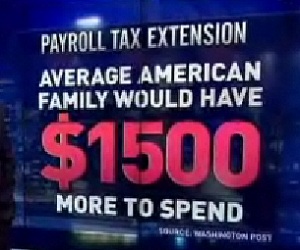Powering The Economy By 99% – Is the payroll tax cut heading for the fiscal cliff? Will the GOP be on board this time?
 Our economy’s engine is powered primarily by the 99% of the consuming public: the middle class and lower income groups.
Our economy’s engine is powered primarily by the 99% of the consuming public: the middle class and lower income groups.
Regardless of politics, it is a fact that the 99% spend more of their income to power the total economy than do the top 1%. It is pure logic by the numbers: the costs of the 99%er’s needs make up a much larger proportion of their income than those same needs of the top 1%. The 99% have to spend the money on food, clothing, and shelter leaving little or nothing left for discretionary items.
Hypothetically, for illustration purposes to clarify the math, let’s just say that both groups have to spend a $1 for a meal. If you have to pay $1 to eat and you only have $5 to spend (the 99%er’s cash in hand, for example), that $1 meal is 1/5, 20%, of the 99%er’s money. On the other hand, if you have $50, (the 1%er’s cash in hand, for example), that $1 to eat is now only 1/50, or just 2% of the 1%er’s money.
Staying with this scenario, the option to spend more than $1 on the meal is not possible for the 99%ers, because the remaining $4 must be allocated for the other necessities of survival; whereas the 1%ers have many options at their disposal. For example, the 1%ers can eat a more expensive meal; or eat the same meal and spend the same $4 on their other necessities like that of the 99%ers, thus leaving the 1%ers the remaining $45 to play with or save that balance and invest it in gold, or a hedge fund, or a foreign sports car, … none of which add any stimulus to our economy, at least not directly or immediately, as do the instant dollars spent by the 99%ers.
Do the math: if you have very limited funds to spend for food, clothing, and shelter – the basic necessities, then you must spend that money to eat, clothe, and reside; and, you have no other choice or options available to you! But if you have unlimited or large cash reserves from which to draw funds, you then have many options – to spend … or not spend … and save the remaining balance.
Savings do not stimulate the economy (not as quickly and directly) as consumer spending does. It’s kind of a paradox: what best stimulates the economy is consumer spending; but what best helps the consumer’s financial fitness is a healthy, consistent savings. What’s best for the consumer is not best for the economy and vice versa.
If you are an upper-incomer, you have no limitations as to what you do with your income (within reason, of course, in order to preserve your funds supply); whereas, if you are a lower-incomer your options with your money are limited to your basic necessities of food, clothing and shelter, leaving little or nothing for the un-necessaries, the discretionary things (jewelry, travel, toys, a yacht, for example).
There is much more to this quandary, which even involves the political choices that we make and a political system that is bought and paid for by the big money. Although you might think that you are getting what you vote for, think again. Be as diligent about your voting research as you are with your finances and your health; and, understand that your ideology might interfere with the financial goals that you are trying to achieve!
(video 6:19)
(video 10:28)
(video 13:34)
(video 12:45)
(video 9:25)








